spindle
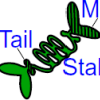 Recent work has shown that the C-terminal tail is particularly important to kinesin-5 motor function and mitotic spindle assembly. We characterized a series of kinesin-5/Cut7 tail truncation alleles in fission yeast. Our observations suggest that the C-terminal tail of Cut7p contributes to both sliding force and midzone localization.
Recent work has shown that the C-terminal tail is particularly important to kinesin-5 motor function and mitotic spindle assembly. We characterized a series of kinesin-5/Cut7 tail truncation alleles in fission yeast. Our observations suggest that the C-terminal tail of Cut7p contributes to both sliding force and midzone localization. We describe the Toolkit for Automated Microtubule Tracking (TAMiT), which automatically detects, optimizes, and tracks fluorescent microtubules in living yeast cells with sub-pixel accuracy. TAMiT detects linear and curved polymers using a geometrical scanning technique.
We describe the Toolkit for Automated Microtubule Tracking (TAMiT), which automatically detects, optimizes, and tracks fluorescent microtubules in living yeast cells with sub-pixel accuracy. TAMiT detects linear and curved polymers using a geometrical scanning technique.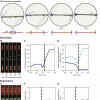 We develop a computational model of fission-yeast mitosis using a course-grained Brownian Dynamic framework in conjunction with a force-dependent kinetic Monte Carlo algorithm to replicate the biorientation and segregation of chromosomes.
We develop a computational model of fission-yeast mitosis using a course-grained Brownian Dynamic framework in conjunction with a force-dependent kinetic Monte Carlo algorithm to replicate the biorientation and segregation of chromosomes.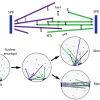 We develop a torque-balance model that describes spindle assembly due to dynamic microtubule bundles, spindle-pole bodies, the nuclear envelope, and crosslinkers to predict spindle-assembly dynamics.
We develop a torque-balance model that describes spindle assembly due to dynamic microtubule bundles, spindle-pole bodies, the nuclear envelope, and crosslinkers to predict spindle-assembly dynamics. Our paper "Theory of cytoskeletal reorganization during crosslinker-mediated mitotic spindle assembly" was accepted for publication at Biophysical Journal.
Our paper "Theory of cytoskeletal reorganization during crosslinker-mediated mitotic spindle assembly" was accepted for publication at Biophysical Journal.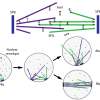 Our paper "Theory of cytoskeletal reorganization during crosslinker-mediated mitotic spindle assembly" was posted on the biorxiv preprint server today.
Our paper "Theory of cytoskeletal reorganization during crosslinker-mediated mitotic spindle assembly" was posted on the biorxiv preprint server today.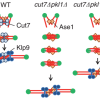 Pushing forces generated by microtubule polymerization are sufficient to promote spindle pole separation and the assembly of bipolar spindle in the absence of molecular motors.
Pushing forces generated by microtubule polymerization are sufficient to promote spindle pole separation and the assembly of bipolar spindle in the absence of molecular motors.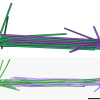 Microtubules, motors, and cross-linkers are important for bipolarity, but the mechanisms necessary and sufficient for spindle assembly remain unknown. We describe a physical model that exhibits de novo bipolar spindle formation.
Microtubules, motors, and cross-linkers are important for bipolarity, but the mechanisms necessary and sufficient for spindle assembly remain unknown. We describe a physical model that exhibits de novo bipolar spindle formation.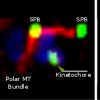 To better understand the role of kinesin-8 proteins in mitosis, we have studied the effects of deletion of the fission-yeast kinesin-8 proteins Klp5 and Klp6 on chromosome movements and spindle length dynamics.
To better understand the role of kinesin-8 proteins in mitosis, we have studied the effects of deletion of the fission-yeast kinesin-8 proteins Klp5 and Klp6 on chromosome movements and spindle length dynamics.

